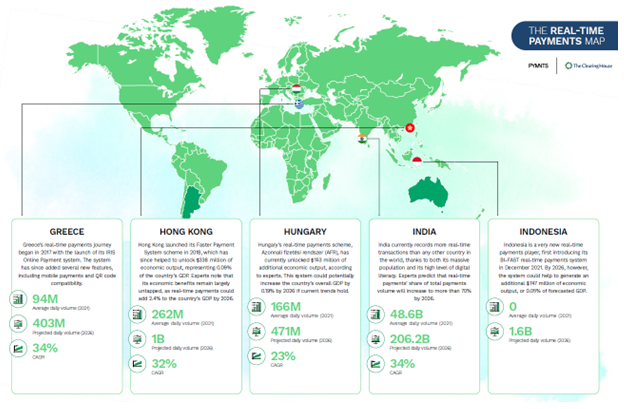Hungary’s Domestic Scheme to Boost Real-Time Payments Volume Nearly 3X by 2026

Real-time payment adoption in Europe has seen historic growth in recent years, with several countries such as the U.K., Sweden, the Czech Republic and Hungary, developing domestic payment systems to complement the existing pan-European Single Euro Payments Area (SEPA) Instant Credit Transfer scheme, also known as SCT Inst.
For example, Hungary’s domestic real-time payments scheme, which is based on SCT Inst standards, Azonnali fizetési rendszer (AFR), has seen significant growth since its launch by Hungarian banks in March 2020.
According to data captured in the April edition of the “Real-Time Payments World Map,” a collaboration with The Clearing House, the AFR local currency system has unlocked $153 million of additional economic output and could potentially boost the country’s overall GDP by 0.19% by 2026 if current trends hold.
The report also reveals that daily real-time payments volume in the landlocked Central European country is set to increase from 166 million in 2021 to 471 million in 2026, growing at a compound annual growth rate (CAGR) of 23% between that period.

These findings were corroborated by data captured in ACI Worldwide’s 2023 Prime Time for Real-Time report, which showed that Hungary’s real-time payments volume represented 5% of total payments volume in 2022 despite its young age.
“This can be attributed to AFR supporting different kinds of payments including individual P2P, bulk and recurring payments, and proving the convenience of making payments using mobile phone number, email address or tax identification number,” the ACI report noted.
In an interview with the EPC when the domestic scheme launched, Levente Kovács, secretary general of the Hungarian Banking Association, explained how the Central Bank of Hungary-backed initiative aims to boost innovation in the payments sector and accelerate the shift to a cashless local economy.
“The goal is to use AFR in as many payment situations as possible in order to replace the cash payments that count for about 80% of retail payments,” he said.
For all PYMNTS EMEA coverage, subscribe to the daily EMEA Newsletter.

